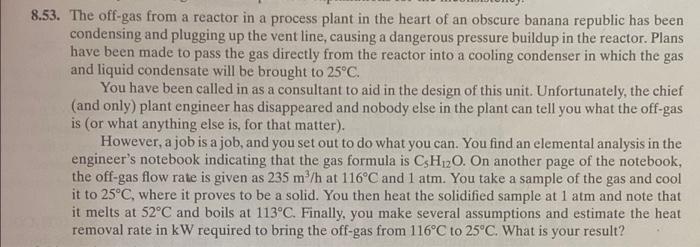8.53. The off-gas from a reactor in a process plant in the heart of an obscure banana republic has been condensing and plugging up the vent line, causing a dangerous pressure buildup in the reactor. Plans have been made to pass the gas directly from the reactor into a cooling condenser in which the gas and liquid condensate will be brought to 25C. You have been called in as a consultant to aid in the design of this unit. Unfortunately, the chief (and only) plant engineer has disappeared and nobody else in the plant can tell you what the off-gas is (or what anything else is, for that matter). However, a job is a job, and you set out to do what you can. You find an elemental analysis in the engineer's notebook indicating that the gas formula is C H20. On another page of the notebook, the off-gas flow rate is given as 235 m /h at 116C and 1 atm. You take a sample of the gas and cool it to 25C, where it proves to be a solid. You then heat the solidified sample at 1 atm and note that it melts at 52C and boils at 113C. Finally, you make several assumptions and estimate the heat removal rate in kW required to bring the off-gas from 116C to 25C. What is your result? 8.53. The off-gas from a reactor in a process plant in the heart of an obscure banana republic has been condensing and plugging up the vent line, causing a dangerous pressure buildup in the reactor. Plans have been made to pass the gas directly from the reactor into a cooling condenser in which the gas and liquid condensate will be brought to 25C. You have been called in as a consultant to aid in the design of this unit. Unfortunately, the chief (and only) plant engineer has disappeared and nobody else in the plant can tell you what the off-gas is (or what anything else is, for that matter). However, a job is a job, and you set out to do what you can. You find an elemental analysis in the engineer's notebook indicating that the gas formula is C H20. On another page of the notebook, the off-gas flow rate is given as 235 m /h at 116C and 1 atm. You take a sample of the gas and cool it to 25C, where it proves to be a solid. You then heat the solidified sample at 1 atm and note that it melts at 52C and boils at 113C. Finally, you make several assumptions and estimate the heat removal rate in kW required to bring the off-gas from 116C to 25C. What is your result







